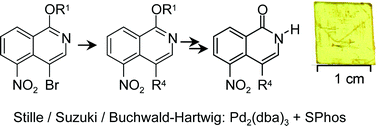Synthesis of 4-alkyl-, 4-aryl- and 4-arylamino-5-aminoisoquinolin-1-ones and identification of a new PARP-2 selective inhibitor†
Abstract
The considerable interest in substituted isoquinolin-1-ones related to

* Corresponding authors
a
Medicinal Chemistry, Department of Pharmacy & Pharmacology, University of Bath, Claverton Down, Bath, UK
E-mail:
m.d.threadgill@bath.ac.uk
Fax: +44 1225 386114
Tel: +44 1225 386840
b Crystallography Unit, Department of Chemistry, University of Bath, Claverton Down, Bath, UK
c KuDOS Pharmaceuticals Ltd., 410 Cambridge Science Park, Milton Road, Cambridge, UK
The considerable interest in substituted isoquinolin-1-ones related to

 Please wait while we load your content...
Something went wrong. Try again?
Please wait while we load your content...
Something went wrong. Try again?
P. T. Sunderland, A. Dhami, M. F. Mahon, L. A. Jones, S. R. Tully, M. D. Lloyd, A. S. Thompson, H. Javaid, N. M. B. Martin and M. D. Threadgill, Org. Biomol. Chem., 2011, 9, 881 DOI: 10.1039/C0OB00665C
To request permission to reproduce material from this article, please go to the Copyright Clearance Center request page.
If you are an author contributing to an RSC publication, you do not need to request permission provided correct acknowledgement is given.
If you are the author of this article, you do not need to request permission to reproduce figures and diagrams provided correct acknowledgement is given. If you want to reproduce the whole article in a third-party publication (excluding your thesis/dissertation for which permission is not required) please go to the Copyright Clearance Center request page.
Read more about how to correctly acknowledge RSC content.
 Fetching data from CrossRef.
Fetching data from CrossRef.
This may take some time to load.
Loading related content
